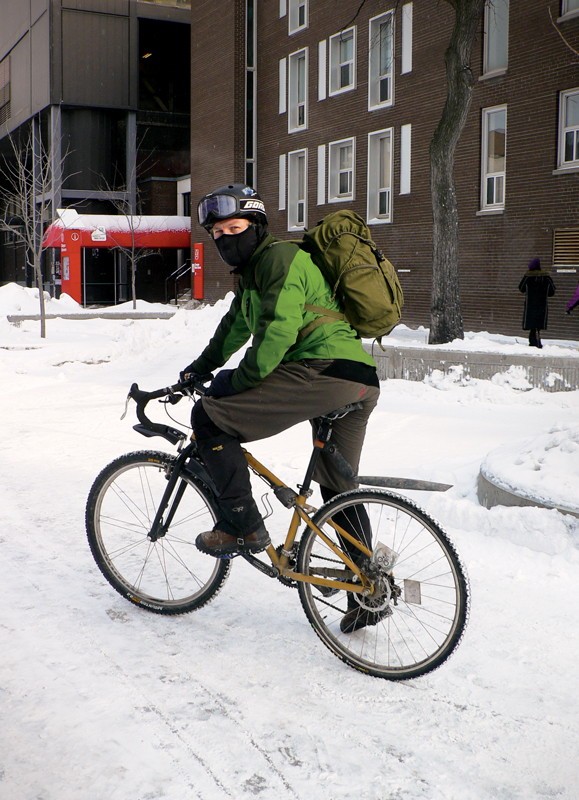Winter biking rises in popularity
Cold but environmentally-friendly option for commuters who want to escape their car
When seen on the road, people tend to use words like crazy. Riding a bicycle in the winter makes no sense to some people, but all the sense in the world to others – even during Winnipeg’s harsh, icy, dark months.
Dave Gooch has been in the bike business for 35 years. The head of bike repairs at Gooch’s Bicycle and Hobby Shops on Sherbrook Street said winter biking has grown steadily more popular over the years, especially in the last decade.
He estimates he gets at least three customers a day coming in for something to do with winter cycling.
“We’re a downtown shop. Commuting is close,” he said.
Being far from your destination is no deterrent for some.
“I don’t see many other winter cyclists while riding from home in Transcona to work downtown,” Kevin Miller said in an e-mail.
Miller is co-chair of Bike to the Future, a Winnipeg cycling activist group.
“If I ride from downtown to Assiniboine Park or through Wolseley, Fort Rouge, or River Heights, I see significantly more.”
Miller has written about winter biking on the Bike to the Future web page.
“Winter cyclists are warm,” he notes in one post, contrary to people’s expectations. “They do not curse the cold because they dress for it and are active in it.”
He goes on to say that “winter cycling is safe” and adds that in ideal conditions, the roads are summer-like.
The consumer side
To endure slippery and frozen conditions, many people choose to invest in extra equipment and clothing.
Jared Falk is a bike repair technician at Mountain Equipment Co-op. He said he sees at least one or two people bring in their bike to be winterized every week. Dozens more buy parts, like lubes and studded tires, to do the work at home themselves.
“We see a wide spectrum of people, from avid cyclists to people trying it for the first time,” said Falk.
He said new cyclists are usually the ones bringing their bikes in, while the more experienced ones buy the parts themselves.
“You’ll get someone who tries [winter cycling] once and hates it and you’ll never see that person again,” he said.
Falk also sees many different kinds of people coming in to get their bikes ready for the winter.
“You see lawyers, downtown office people, quite a few students ... They come in with their dress shoes and their back packs.”
Once the gear is acquired, winter biking becomes easier. Some people choose to take their new gear and try out for some competitive winter biking.
Woodcock Cycle Works, a cycling store in St. Boniface, sponsors an annual ice biking race at the Forks. Icebike is in its 12th year pitting people against each other on the four-kilometre course. Entrants race up to three laps.
Skills required
Those who choose to ride in the winter need to be confident and able.
Sgt. Darrall Kotchon, head of the Winnipeg Police Service’s bike patrol unit said that due to the harsh conditions, there are fewer cyclists on the road in the winter, most of whom are more experienced and skillful.
Fewer accidents happen as a result, and those that do are usually the result of environmental factors such as ice or debris, not the rider’s skill, said Kotchon.
A winter cyclist himself, Kotchon has experienced the animosity of some motorists towards their two-wheeled bretheren.
“I’ve had occasions where people have given me the finger,” he said. He also said he has been hit while riding out of uniform.
The Highway Traffic Act stipulates that cyclists should ride as close to the curb as possible, but they may take the whole lane if it’s blocked by snow. Kotchon said it’s when cyclists ride on the sidewalk or against the flow of traffic that the chance of an accident increases.
According to Manitoba Public Insurance, between 2004 and 2008 there were zero reported fatalities involving bicycles and vehicles in the most harsh months, November through February. Compared to the 16 fatalities reported in the spring-fall season, winter conditions seem to make commuters more careful.
Unsurprisingly, the traffic-heavy month of June holds the most MPI claims for bicycle-vehicle accidents annually.
Gooch thinks the conflict between motorists and cyclists is overblown.
“It’s the minority that always ruins it for the majority,” he said. “You never hear about the courtesy stuff. You never hear about, ‘Oh, this guy let me in.’ We only hear the whining.”







